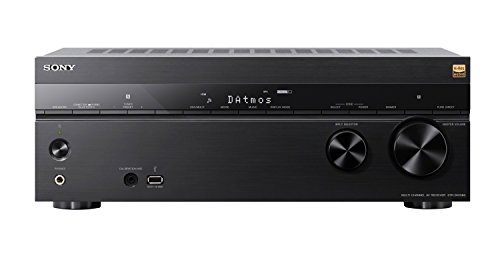
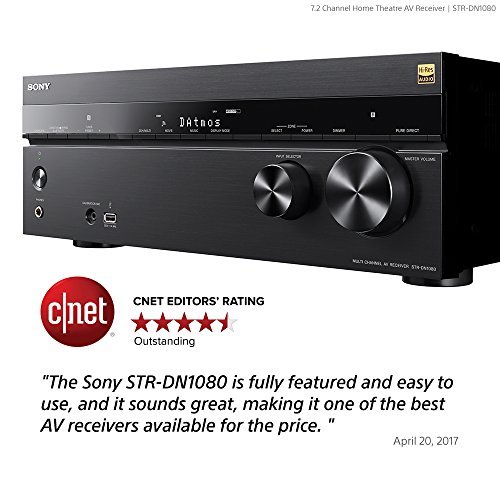
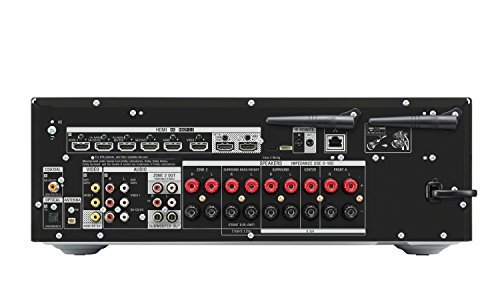

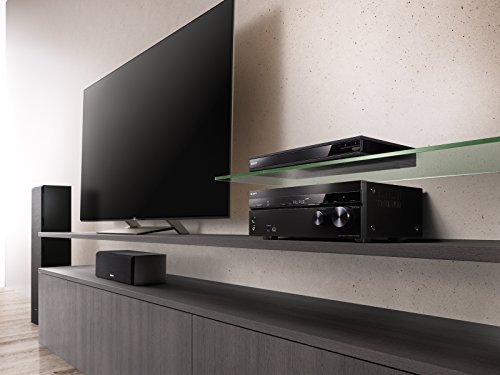
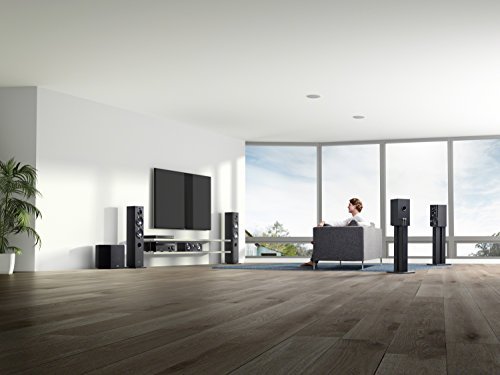






Expand your listening and control with multi-room and Google Home compatibility
Experience true home theater without limitations with this 7.2 channel receiver with Dolby Atmos 3D and DTS:X object-based surround sound, plus 4K HDR and HDCP 2.2 compatibility. Enjoy the flexibility of 6-in/2-out HDMI2 and multi-room listening, plus voice control powered by Google Home. All in a smaller chassis that fits more places.
Note: the following observations are the result of actual hands-on testing. Being a new pre-release model there are some conflicts in technical details between the product page and Sony’s site. This is normal. Once the product hits the mainstream in May 2017 if anything below needs clarification it will be updated.This review is long. It is intended for the person who is considering paying for a top-of-the-line home entertainment system receiver. I tried to summarize my thoughts on whether it is worth it in the final paragraph.I purchased my first Sony-brand receiver, the STR-DN1050, when it first came out in 2014. In the world of high tech audio/video the 3 years since is considered a millennium. Previous to that purchase I had considered Sony to be more of a mainstream brand and my personal preferences ran more to the brands that are perceived to be in the upper audiophile end (not that Sony isn’t in that market, because they are). But with home-entertainment systems becoming equally focused on video as well as strictly for music reproduction it seemed logical that Sony was well established in both media and they certainly know a lot about movies and video.Overall my satisfaction level with the DN1050 has been very high in terms of multi-channel movies and general everyday listening; good on convenience features and better-than-average on user-friendly interface. My only disappointment is that sometimes after being run at high volume for a few hours the built-in thermal protection powers the amp down to cool, which not too cool when we’re in the middle of a movie. I take most of the blame for that though because my receiver is in an open cabinet with a shelf above it which traps the heat. For my new 1080 receiver I bought a component fan exhaust accessory AC Infinity AIRCOM T8 Quiet Cooling Blower Fan System to help channel the heat away from the unit.Why am I comparing this to the STN-DN1050? Essentially that was the first of this series (the STN-DN1040 was enough different to warrant being excluded) and it is old enough some that some 1050 (and 1060 & 1070) owners may be thinking of upgrading to a newer model, hence a model vs model comparison.The STR-DN1080 is brand-new (first deliveries April 30, 2017). It breaks no new ground as far as form-factor or user interface and the basic specs are virtually identical. As Sony historically has done the changes are evolutionary rather than revolutionary. But appealing to my audiophile tastes are several new enhancements to sound reproduction that edge it closer to a premium audio amplifier.NEW OR CHANGED FEATURES over the previous models in the series1. Dolby Atmos (sound from above the visual field using additional speakers - see more about this below). Sony’s first receiver to fully implement this feature.2. DTS:X added - being compatible with the newest formats is always a good thing. Sony’s first receiver to fully implement this feature.3. Sixth HDMI port removed from front panel for easy access and now included with the usual I/O section on the rear panel4. A 4K repeater feature allows data to pass through the receiver without compromising image quality, and it has HDCP 2.2 support, all at 60fps5. HDR support - now that 3D TV is officially dead, 4k and HDR are the big buzzwords you see in the ads for the hottest new TV’s6. Removed one HDMI output (now has 2 instead of three). With many new TV’s now equipped with 3-6 HDMI inputs and some of the newest ones with external I/O boxes having as many as 8 (which could mean as many as 14 HMDI inputs total when combined with those on the 1080), for as many AV gadgets as I own I don’t think I’ll ever complain about not having enough inputs. Six is fine for a receiver in this class, if I wanted more that’s an easy thing to fix or I’d simply just choose a different model. I would rather concentrate on audio and video performance than quantity of I/O ports.7. Removed all component connectivity jacks. Most users probably won’t miss these as very few consumer TV’s have them anymore.8. There were two Toslink optical ports on the rear of the receiver, now there is only one. In my opinion is too soon to eliminate optical audio connectivity from home entertainment equipment. There still is a Coax audio input, which I need and use.9. Two outputs for powered subwoofers (unchanged), much appreciated by me. Although subs are omnidirectional I have three of them because of the dynamics of my listening room. Two of them can be driven off the second port and controlled by the speaker controls/equalizer10. Speaker terminal array was 3 pair plus center, is now 3 pair plus center AND dedicated posts for non-powered Zone 2 speakers in addition to ports for powered Zone 2 speakers (or Atmos)11. Added second Wi-Fi antenna for dual-band Wi-Fi for Airplay, DLNA and Chromecast. The system also supports Spotify Connect and Sony’s SongPal Link system.12. DCAC EX auto calibration - auto calibration from most of the major manufactures continues to improve. This is an improvement over earlier attempts. I use it for initial setup but I can always do better using my ears for final tweaking. In real life what this does for you is to give you the effect of actually moving and aiming your speakers sound dispersion (Speaker Relocation) when physically moving them is not possible (see more below)13. Works with Google Home14. Chromecast built-in (part of the Google Home feature set but there is an iOS app as well)15. LDAC: for the transmission of High-Resolution Audio content with a LIMITED number of currently available compatible devices (nice, worthwhile and forward thinking)16. Phantom Surround Back - creates the illusion of more physical speakers17.Virtual surround with S-Force PRO Front Surround (nice to have and the effect can be better than a soundbar but is it realistic that someone would choose one of Sony’s top-of-line multichannel receivers for use with only two speakers?)18. BT-TX - previous models in this series would only play FROM a Bluetooth source, like maybe your smartphone. This model will play TO a device (like Bluetooth headphones) as well. This is a feature I LOVE and use every day!!19. Audio enhancements (see below)20. A very minor detail that happens to be important to me is the overall height of this model is about ¾” less than the 1050. That extra space above the 1080 makes a world of difference in terms of air circulation. For some users the height difference may also make the difference whether or not the receiver will fit where you would like to put it.21. There are several more features that aren’t as prominent but illustrate Sony’s commitment to audio reproduction. Features like “In-Ceiling Speaker Mode” which reproduces more natural sound by lowering the position of audio output from speakers installed in the ceiling and “Center Speaker Lift Up” which is supposed to produce natural sound that feels more authentic by lifting the sound from the center speaker up to the height of the screen. While these features are buried in the small print they both work and are both useful to me. I have no choice how high my ceiling speakers are mounted, I can’t move my ceiling, but the fine-tuning lets me move the sound field closer to the listening area. If you use a center-channel speaker you know it’s impossible to mount it in the true center of your TV screen. Lift Up electronically repositions the important dialogue speaker so it sounds more like it’s coming from inside the TV screen rather than under the TV screen.IN REAL LIFE USE IN MY MEDIA ROOM SETUP(Gear: test source content Sony UBP-X800; display LG 75UH8500; custom Mirage MX-series x 8 + powered sub/JBL 3635 subs x3)Starting with Dolby Atmos, I reconfigured my speaker array to take advantage of it. I installed an additional pair of speakers 20’ up in my cathedral ceiling. Whether the source is actually Atmos encoded or not (and I don’t own a lot of content that is) the improved aural effect for everyday listening is a huge wow.Note: Sony posted an answer to a user question if this has phono inputs. They said yes. Assuming the question is referring to an equalized low-level input from a turntable, IT DOES NOT. It has three pairs of legacy line-level RCA inputs but no dedicated phono turntable low-level inputs. To use a traditional turntable you would need to add a separate pre-amp.While I welcome the Google Home compatibility I am displeased with the “format wars” with a major company like Sony choosing sides. Google Home is one of the newest and there is a huge established base of Echo users (not to mention Siri). Why not just be universally compatible with them all? I know Sony isn’t alone in the lack of universal control but as a world audio/video leader they could set a precedent.As far as audio quality enhancements, some are meaningful and if course some are marketing hype. While I can’t do a real-time A/B comparison between this and previous generations of this series, I did play my usual audio “test” material in a same-day comparison on both receivers and I am very impressed with what I hear from the 1080. Their small tweaks ultimately do result in a perception of a more natural overall sound.One appreciated feature is that Sony has dispensed of the odd specialized sound fields like the Berlin Philharmoniker, Concertgebouw Amsterdam and Musikverein Wien (which to me always sounded phony) and drilled back to those that really matter. The slimmed down sound field choices now represent real life sound environments like stereo, multi-channel, Dolby Surround, headphone (yes, really, a sound field dedicated to headphone listening), and a very few other fields, none with esoteric names.One thing that intrigued me is DCAC EX … I’ve used various “automatic” setup schemes since they were introduced and while I like the basic concept they baffled me how they could be totally accurate only using a mono microphone. Hint: they weren’t. They gave a rough order of magnitude how loud each speaker is and even took a good guess at how far it was away from your listening position, but with a mono mic they couldn’t really tell you if the speaker was too high or low or was too far to the right or left of optimum position or if the transducers were pointing right at you. Now equipped with a stereo microphone, DCAC EX is a significant improvement in making those calculations and attempts to autocorrect for positioning, aiming and phase. Does it work? Well, every room is different and my room is a definite challenge but I would say once you try it you will think previous methods are primitive by comparison.A backward step considering how warm this receiver can get is that for some reason Sony reduced the surface area of the top vents almost by half. Looking inside the unit through the vents it appears there are less electronics inside. Maybe it runs cooler? I’ll post some test results later on.Coupled with the observations that the cabinet is smaller and there may also be less electronics inside the 1080. From my casual peek through the vent grill without opening the cabinet it does seem to have less electronics inside.Sony, who is usually so good at keeping their user interface simple yet useful certainly accomplishes the former with the included remote control (if you use it … I have my system under Harmony/Alexa control). Unlike the remotes of some other brands that have dozens of tiny buttons that control nearly everything their device can do, Sony chooses to offer only 26 buttons (plus the D-pad array … 2 more buttons than the previous model) that are permanently labeled, some of them for functions a user may only rarely, or never, use. At the least I would have preferred to have a dedicated button for each of the inputs. You CAN remap the button functions to almost anything you want (including one cool custom button that can remember your exact preferences) but of course the permanent labels remain. I did remap it so there is a dedicated button for each of the 6 HDMI inputs and also 2 audio-only inputs but I had to resort to using stick-on labels to help me remember what they are.One more real-life observation has to do with setup. Like my previous Sony receiver you can choose (or not) to have the unit go through a guided setup procedure. Oddly, Sony gives the user an option if they want to start by setting up either the network or speakers first. I highly recommend choosing to do the network first. When you do, it will seem like nothing’s happening and you may think your unit is defective. Be patient, for some reason it takes a long time for it to do some internal preliminary adjustments. The problem is it doesn’t tell you in any way what it’s doing. After a couple of minutes it finally got to asking me what my preferred language is, which is typically the most basic question a new device asks. From there the next screen needs to have you make some choices. It is one of the very few screens on this unit that isn’t as clear as it should be. Having used Sony setup screens before I was able to breeze through the network setup in about 30 seconds after that and it worked the first time as it should. By default the receiver will prompt you when there are any software/firmware changes (you can turn that auto-prompt off) but it would have been nice if the first time you turn it on it confirms that everything is up to date. I had to check manually to be sure.HOW DOES IT SOUNDHaving worked extensively in pro recording studios I have a pretty good audio memory. My home system has had a wide range of the major brands of AV equipment installed over recent years. Since I installed this receiver immediately after pulling a similar Sony model that is still shown as current at their website I can offer an opinion if there are any changes for better or worse in overall sound quality. Before I do I’ll mention that in MY system there was no visible improvement in video quality but I have to clarify that it’s possible that the 1080 is ahead of the curve compared to the rest of my system. But as far as sound, yes there is some good news. Before I added the upper speakers, playing the identical source in the same way, I perceive a bit more clarity. By that I don’t mean sharpness or brilliance … those are to me traits that Sony is known for (as opposed to the warmer more natural sound some other brands are known for). With this generation Sony has opted for a slightly warmer sound. Dialogue sounds more like human voices than electronic loudspeakers. Low-end bass from the subwoofers (I have 3) is slightly tighter and less boomy. Overall it’s more of a fine tuning exercise from Sony than a radical shift in the “Sony sound”USER FRIENDLINESSSony has chosen not to dazzle with a lot of blue lights, chrome and buzzwords emblazoned on the front of the receiver. The styling is basic black and very restrained. The buttons are tiny and hard to read by comparison to some other brands. The input selector and volume knobs have a smooth feeling but does anyone really use them rather than the remote control and excellent on-screen menu instead? The remote, by the way, has very few dedicated buttons but what it does have can be user-customized. I use neither, preferring to control my system with a Harmony Elite/Echo combination. Finally, the on-screen menu (GUI) first introduced in its current form on the 1050 and slightly updated on this model is as good as it gets … crisp high-resolution graphics, clear easy to understand wording, logical choices all make for a superb user experience. The setup section is especially good, where you can dig deep and then even deeper into fine tuning controls that are accompanied by icons representing your speaker locations (which it knows without you having to tell it). Most of the adjustments allow you to hear the results of the audio changes in real time. That may not sound like a big deal but another well-known brand switches the audio off during setup adjustments which makes it pale by comparison to the Sony.Reversing a common trend lately of not including a user manual with their products (a $3000 Sony camera I bought recently only has a one page manual), this receiver has an impressive amount of printed documentation included.BOTTOM LINEI originally bought the STR-DN1050 because after a lot of shopping it seemed like the best value, all things considered. If you have a 1040, 1050, 1060 or 1070 the 1080 may not be the quantum leap to cause you to replace your old receiver. Moving up a few generations of this model is in some ways like upgrading the OS on your computer or smartphone … the device still does the same basic thing but better with little improvements that make your experience that much better. If this is your first look at Sony and you are seeking a receiver that ticks (most of) the boxes in terms of being compatible and keeping up with technology, the 1080 is worth giving serious consideration.Why a 5 rating then? Per guidelines I lean toward giving things I like a positive 4, rarely higher, with that extra point reserved for best of class. This receiver isn’t in that best-of-best stratified league but it’s hard to dispute that it is exceptionally high on overall value, functionality and usability and for those factors it earns 4+. Putting all those aside though, I believe Sony hits a home run here with what I call enjoyability of multimedia listening. It simply sounds better than any full-functioned multi-channel receiver I’ve owned when used for home theater, which is the way I’m using it … more natural, more accurate and yes, more impressive. All that’s important to me as I continue to update and upgrade my video components and I seek to keep up to speed on the audio side as well. To be sure this is not the best audiophile-grade MUSIC amp I’ve heard, far from it, but that’s not what it’s designed to be. But for home theater the score is 4.75
I have had audio receivers for about 20 years now, and this is by far the best one I have ever had. The installation process could not be simpler. The HUD is great, simple to use and very user friendly. The ONLY gripe I have is you have to go deep into the setting to enable HDR through each single HDMI port. That should just be automatically turned on.Either way, the sound out of it is great, huge difference from my last one. This is by far the best receiver you can buy under $600.
Excellent amplifier, arrived when expected & in perfect condition. Set up was very straight forward and the output is far superior to what we had been using previously. It drives our main 6ch speakers with power to spare, as well as our secondary speakers in our bedroom. Sound is much clearer & crisper than our previous set also.
I bought Sony STRDN 1080 as a replacement for my 7 years old Sony receiver. The sound quality is really amazing even with non Dolby Atmos or DTX X sources. I always turn on either Dolby Surround or DTX Neural X on to get the best surround sound quality. It makes existing stereo and non Dolby Atmos or DTX X content sound really great. I also use high speed HDMI cable to connect my 4K TV (HDMI ARC) and the receiver. The receiver will upscale the pictures from all sources and the results are very good. The pictures look more colorful and show more details. I really recommended everyone to buy this receiver at such a good price point.
I had a Sony STRDA2400ES that worked, but never ideally…you really had to keep an eye on it, and make sure it was in the right mode. However, this new one sounds great, and is far easier to use. I think I bought the old unit at a time when the interface/standards/decoding weren’t fully matured.
Sounds better than the Yamaha I replaced. I love HDMI inputs and dual HDMI outs, but still trying to figure out how to duplicate the output (it may not duplicate with two separate resolutions). Easy to set up. Great visual on-screen set-up program. I was surprised it didn’t have controlled outlets, but not a big issue. Overall a great product!
Sounds huge, which is exactly what you want from a home theater receiver, but ultimately got returned because a) multi-channel stereo would only work with music (not when watching television streamed in stereo like HBO Now or PS Vue), and b) only 5 of its 6 HDMI inputs are HDCP 2.2 compliant, so you really can only pass through 4K signal on 5 HDMI inputs. I ended up going with a more expensive Denon and am completely happy.
This unit replaced a Dennon that didn’t last 3 years. My Sony lasted 12.. So far this unit has not disappointed. I recommend it for the price.
Ahhh…the sweetness of sound!! Great transistion frommy old Yamaha and the price was right!
—– FM antenna connector silliness. Instead of a perfectly standard coaxial RF connector (whether Belling-Lee, F, or RCA), they decided the plug on the back of the amp should be…
The product worked well and produced high quality sound. Gave it one star because of product reliability. Product simply stopped working after 3 months. It will no longer turn on.
It was a gift.
I’m torn whether to give this 3, 4 or 5 stars. It has some good points and some bad points.Overall it serves its purpose well, so I ended up giving it 4 stars.
We’re so glad we purchased the Sony STRDN1080 receiver. It’s what we hoped for, and more!
The receiver is easy to setup. The included calibration microphone works great and is able to automatically set the sound levels of the speakers.
Product was pretty impressive at first. Once I got all the wires and everything configured, I found that the center speaker outputs didn’t work.
DO NOT buy Sony products that advertise mobile device support. They have just recently stopped support of the STRDN1050 in their mobile app, effectively making the unit obsolete.
comments powered by DisqusThis receiver had a couple of glaring problems; the biggest was the fact that no matter what setting or fine tuning I did with levels and crossovers and eqs, the center channel…